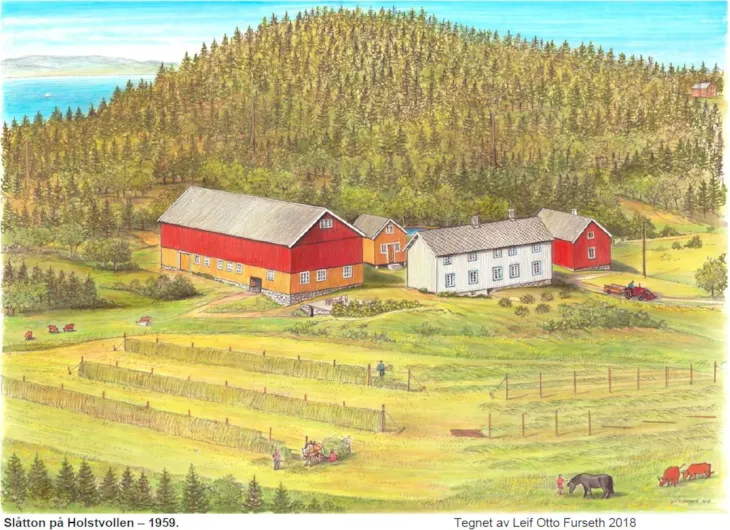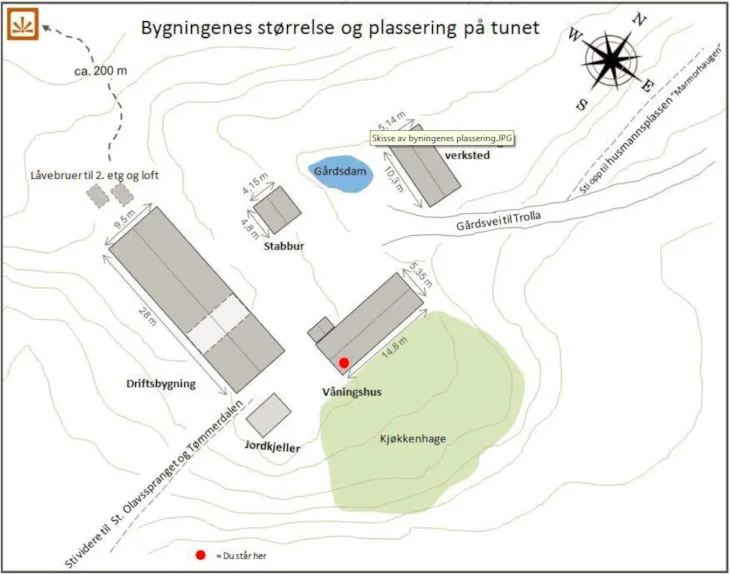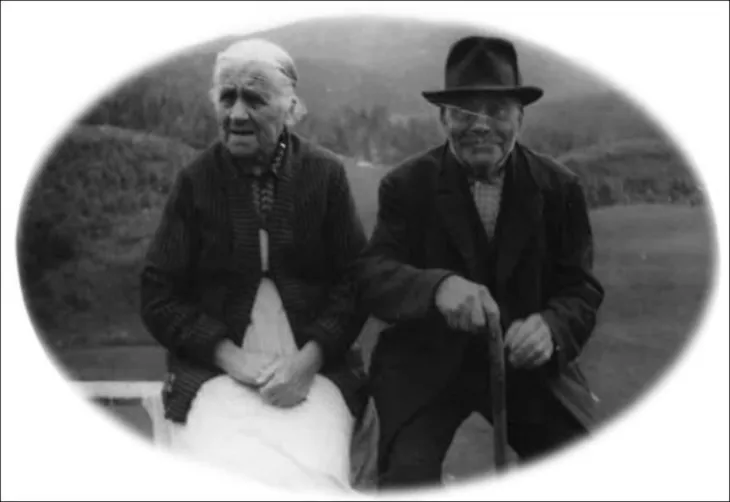Holstvollen - English
Holstvollen - English
Innhold
Bymarka
Trial excavations and other archaeological studies show there existed agricultural settlements in central parts of Bymarka from the early Iron Age (approx. 500 BC) to the late Iron Age (approx. AD 1030). Discoveries of Viking Age swords at Sommersetra and Trolla indicate that the Vikings also used Bymarka.

Viking swords from Sommersetra. Photo: Per E. Fredriksen.
In an appendix to Magnus Lagabøter's “City Law” from around 1310, Bymarka is described as an area outside Trondheim that fell under the city administration’s jurisdiction. It was referred to as “takmark” - an area where townspeople could graze animals and collect firewood. The boundary between the city and the “takmark” was at Ilen, and the outer boundary was drawn from Folafoten on the coast, via Gråkallen and through Skjelbreia. Note the outer boundary to the left in Schiøtz and Gløersen`s map from 1896 below.

Holstvollen gård was one of several farms located within this area.
In the area west of Holstvollen are several mine entrances or adits, the result of around 30 licences being issued to extract copper and sulphur clay between 1860 and 1930.
Holstvollen farm

Slåtton at Holstvollen – 1959. Illustration by Leif Otto Furseth 2018
Holstvollen farm was an area of pastureland situated north-west in Bymarka.
Holstvollen covered approximately 150 acres (60 hectares), of which 24 acres (10 hectares) was agricultural land. At the end Holstvollen consisted of five buildings:
- The farmhouse (våningshus), with a floor area of 160 m² over two floors and a cellar.
- The barn (driftsbygning), with a floor area of around 300 m² over three floors including the hayloft. The barn had two access bridges on the northwest side of the building.
- The “stabbur” (a traditional Norwegian storehouse on pillars) with two floors.
- The cart shed with workshop (verksted).
- A root cellar (jordkjeller), partly underground and built in concrete and stone (still standing).

The oldest part of the farmhouse building was erected the latter half of the 19th century, while the other buildings were added between 1920 and 1930.
Named after Trondheim dignitary Holst
The farm is named after Trondheim chief administrator Lorentz Holst, who acquired the land in the 1720s and erected a house on it. He also built a dam (Holstdammen) to provide a regular supply of water to his sawmill at Trolla Brug.
Link to Trolla Brug
In 1765, the town magistrate gave Henrik Lysholm, Peder Iversen, Knut Thode and Gert Hornemann, who had bought Trolla, Myren and Holstvollen, a lease to operate a sawmill at Trolla Brug. The leaseholders had a so-called “copyhold”, which meant that the sawmill could be passed on as an inheritance. Those in possession of inheritable leases were generally people of high standing in the community, while others would be employed to live and work at sites such as the Trolla Brug sawmill.
Holstvollen was a relatively large farm, comprising pastureland, forests and rocky hills. During the latter part of the 18th century and in the 19th century it changed hands several times. In 1801, the census had Holstvollen and Myra registered as covering over 120 acres.
Widow as leaseholder and tenant farmer’s family
After a period of changing tenants, the leasehold was taken over in 1865 by the widow Karen Pedersdatter who ran the farm together with her sister from Romsdal. They also employed a farm hand. In addition, a man called Ole Haagensen (60) lived here with six family members. Haagensen is described in the population census as a “tenant and sheepskin maker". Karen Pedersdatter and her sister had one horse and four cows, while Ole and his family had fourteen goats. Both families grew barley, oats and potatoes.
Growing corn at Holstvollen might seem improbable today, but in the 1800s it was absolutely necessary, among other things, for making bread. Ole Haagensen came from Lösetsetra in Folddalen and had a “colourful” past. In March 1852, he applied for and received 30 rix-dollars by Surnadal municipality on the condition that he left the village and never returned! How he ended up at Holstvollen in Bymarka is unknown, but relatively late in life he cleared and built his own place near Løften, situated on a steep hillside north of Holstvollen, down towards the fjord. From then on, Ole was only known as "Løftkallen".
The Holstvold family
In 1896, the Holstvollen lease was taken over by the Asphaug family from Stadsbygd, which ran the farm for three generations before the next generation took the name Holstvold.

Anders (1856-1943) and Marta Asphaug (1856-1940). Photographer unknown.
In 1910, Anders Danielsen Asphaug, his wife Martha and three unmarried children lived in one half of the farmhouse, while their eldest son Daniel lived in the other half with his wife and four children. The two families shared the kitchen. Anders ran the farm while Daniel worked as an iron founder at Trolla Brug.
Daniel took over the lease in 1926, followed by his eldest son, Arthur.
In 1945, Arthur handed the farm to his brother Josef and moved to Hommelvik.
Josef Holstvold was thus the last person to run the farm, together with his wife Nikoline.
Nikoline and Josef
Nikoline was born in 1910 and came from the neighbouring farm in Nordre Tømmerdal. In 1929, aged 19, she moved in with Josef Holstvold and the following year they were married.
Josef built a small cabin (6m x 4m) a few hundred metres from Holstvollen. It was called "Litjmarka" and was situated behind the farm, to the east of Marmorhaugen hill. They lived there for around 15 years before taking over Holstvollen in 1945. After the move, Litjmarka was rented out for a number of years.
Nikoline and Josef Holstvold had two children, but both died in their twenties.

Joseph was born in 1904. In addition to running the farm, he also worked for a while at Moksnes Metallvarefabrikk in Ila as a tinsmith. Later, they both worked at a plant nursery at Sommersætra, and later still found jobs in Trondheim until 1965.
Fatal accident
During the period surrounding the First World War, wood and timber was scarce in Trondheim, and lumber activity started up in the northern part of Bymarka. Nikoline’s father, Ragnvald Tømmerdal, was engaged in this work. In 1917, he was working at the St Olavsspranget immediately northwest of Holstvolden. While transporting logs, the load slipped, and Ragnvald, horse and load crashed down a steep slope. Ragnvald was killed instantly. Nikoline was 7 years old when her mother became a widow.
Trolla school
Before 1859, the teacher would go from farm to farm to teach. In 1859, children started going to school, which was no more than a room in the teacher’s house. Then in 1868, the municipal authority built a school in Trolla. The number of pupils at Trolla grew steadily, and in 1902 a new school was completed. Four teachers worked at the school, which was now located by the sea east of Nybygningen in Trollafjæra.
It was here that Joseph met Nikoline. They had the same route to school – down the hill at Løften, along Løftbekken down to the track by the sea and from there on to Trolla. They often joined up with the children from Tømmerdalen.
In the winter they would go to school through the forest on skis. In 1933, the school in Trolla was closed down, and the children got a lift to Ila school. If they were late for the lift, they had to walk from Trolla to Ila.
During the war, children from Trolla and Holstvollen returned to Trolla school. 1st, 2nd, and 3rd years were taught in one classroom, while 4th, 5th, 6th and 7th years used the other classroom.

Trolla school 18.02.1913. Photographer unknown. Trondheim City Archive.
Holstvollen during the war
Even though the farm was secluded, the war was felt here, too. When air-raid sirens went off in Trondheim, they were also heard at the farm, and the root cellar was often used as an air-raid shelter. In Trolla, the Germans built a prison camp for Serbs, but sometimes the prisoners would escape the compound. Aud Kirsten Danielsen, who was the daughter of Joseph's sister Dagny born at Holstvollen in 1931, related how the prisoners of war would come to Holstvollen barefoot and thinly dressed to beg for food.
The post-war era
From 1945 to 1971, the farm had its heyday with two horses, four bulls, four dairy cows and three pigs. In addition, they kept hens, cats and a dog. Joseph and Nikoline also grew corn, potatoes, fruits, vegetables and garden berries. They delivered milk to Trolla by carrying milk pails across the fields, often using a wooden shoulder carrier with a pail on each side.
During the summer, farming also included salmon seining under licence at Løften, where they had a boathouse. This carried on until the 1970s. Before the road to Trondheim was built, they transported their catch to Ravnkloa by rowboat for sale, if it had not already been bought on the spot.
By the end of the 1950s the farm had a tractor, but it was not until 1981-82 that a forest road was built from Trolla to Holstvollen.
Last chapter
In 1972, the heritable lease was redeemed from Josef and Nikoline by the Trondheim Municipal Authority. They were still allowed to run the farm, however, and did so until they moved to an apartment in Ila in the mid-1990s. Nikoline died in 1998, aged 88, while Joseph lived on until he was 96. He passed away in the year 2000. They are both buried at Stavne cemetery.
Holstvollen and Litjmarka/Marmorhaugen were demolished in 2017, following a local authority decision.
Text: Byåsen Historical Society and Trondheim Municipal Authority.
Information about and photographs of the Holstvold family are reproduced with the kind permission of the family’s closest descendant Aud Kirsten Danielsen.
Holstvollen drawing by Leif O. Furseth.
Artikkel om Løftkallen - Et Liv på Skyggesida i Byåsminner
Artikkel om Josef og Nicoline på Holstvollen fra Ila menighetsblad.
Sist oppdatert: 22.10.2018